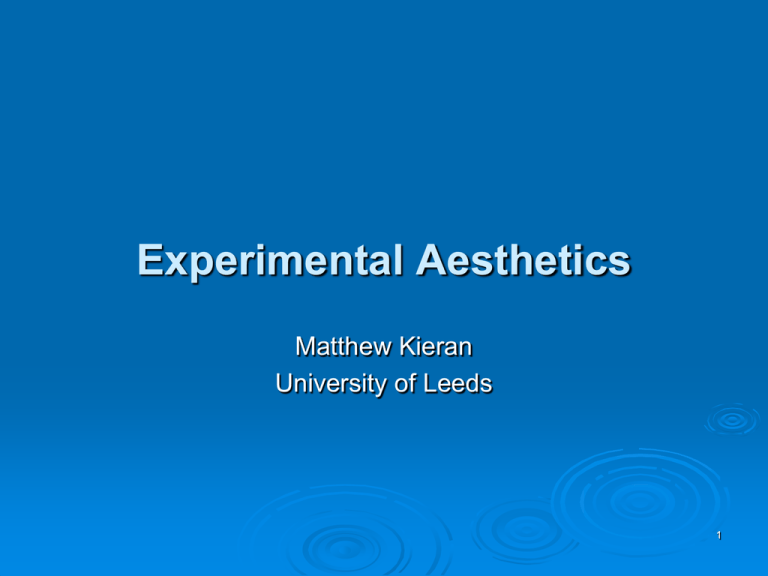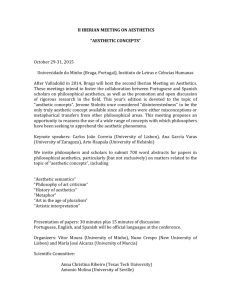Experimental Aesthetics
advertisement

Experimental Aesthetics Matthew Kieran University of Leeds 1 Philosophical Aesthetics v. Psychology Aesthetic explanation and justification are not susceptible to low level psychological generalization and “aesthetic questions have nothing to do with psychological experiments, but are answered in an entirely different way.” Wittgenstein, Lectures (1967: 17). The results of and generalizations from experiments concerning subject preferences or reasoning processes are irrelevant to aesthetics and to think otherwise conflates empirical matters with conceptual ones. Thus, for example, “experiments polling subjects on th meaning of a passage of music are pointless since this sort of inquiry is not a scientific one to which the collection of data is relevant; it is a logical inquiry about language.” Dickie, ‘Is Psychology Relevant to Aesthetics?’ (1962: 349-60). 2 Aesthetic Value It is constitutive of or at least a mark of aesthetic value that we take pleasure in the activity of appreciation. This is defeasible due to: Conditions of viewer and appreciation Role of expertise (capacities, knowledge etc.) It is a desideratum of any account of aesthetic value that it precludes certain kinds of reasons as playing a fundamental justificatory role in underwriting aesthetic judgements. E.g. cost, age, class etc. Natural presumption is that we are pretty good at recognizing when, where and why we appreciate something as we do. 3 A Distinctive Wine Tasting (Plassmann et al) Subjects informed they would be asked to taste 5 different wines to study the relationship between tasting time and perceived flavours. Each putatively different wine was identified by supposed price. Two wines were administered twice - $5 and $45 price, $90 and $10 price. All subjects reported tasting 5 different wines and the expressed preferences correlated to price cues. 4 The Original Wine Experiments Brochet’s wine experiments (2001): 1. 54 oenology students served the same white wine from two bottles and in one of them dyed red. No one noticed (and used characterisations you’d expect of red wine for the white wine dyed red). 2. Same wine decanted into a plonk bottle and a grand cru bottle. 40 said the wine in the fancy bottle was worth drinking but only 12 said 5 the wine in the cheap one was. Cutting’s Impressionism Experiment Cutting established independently that students generally preferred more widely reproduced Impressionist works from those rarely reproduced. In his Intro to Psych class he then presented for 2 sec. at the start of a lecture slides of Impressionist works with the more widely reproduced of a pair presented once, and the more rarely reproduced four times). At the module end students showed marked preferences for the works most frequently shown during the module even though they could not reliably recall whether they had seen the works before. 6 Some Worries Experimental subjects were not expert appreciators and there is good reason to assume experts would be more robust in the face of priming effects (Hume). Appreciation and judgement conditions were atypical and unsuitable. The failure to recognise the usefulness of heuristics or other possible effects on appreciation of familiarity The possible limitations of effect. Priming might have bite only amongst works or aesthetic objects of a certain worth (i.e. no effect where dealing with bad works). 7 A Challenge Nonetheless there is reason to hold we are bad at recognising where, when and why defeasibility conditions apply. The aesthetic realm, due to the role of pleasure, refinement and the relationality of the aesthetic, is particularly susceptible to exploitation for social reasons E.g. snobbery Experiments suggest it is often hard for us to know either in first or third person cases what is driving our judgement. For any given subject’s aesthetic judgement it is often difficult to know whether or not it is justified or whether we or others are in a legitimate position to make knowledge claims. 8 One Possible Way Forward Consider aesthetic appreciation and judgement in virtue theoretic terms. It makes sense of why good appreciation and judgement are achievements and makes sense of how it is achievable i.e. grounded in the exercise of appreciative virtues. By contrast, for example, snobs fail to appreciate works qua aesthetic object properly since they are badly motivated and evaluate works according to inappropriate criteria bound up with social esteem. Hence snobs are to be condemned (i.e. manifest appreciative vice). 9 General Points Experimental psychology can and should inform the kind of accounts we seek to give regarding epistemic and normative issues within aesthetics. Attention to such research can present new challenges to traditional accounts (e.g. of appreciation and judgement within aesthetics). Furthermore, at least to those with anything like naturalistic inclinations, we would surely want and expect our philosophical accounts of the epistemic and normative nature of appreciation and judgement to be consistent with human nature. 10





